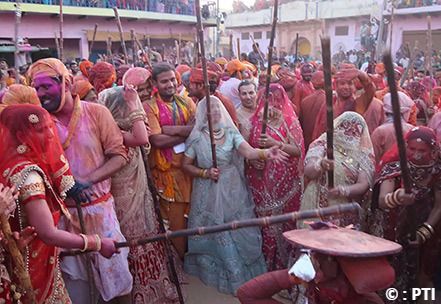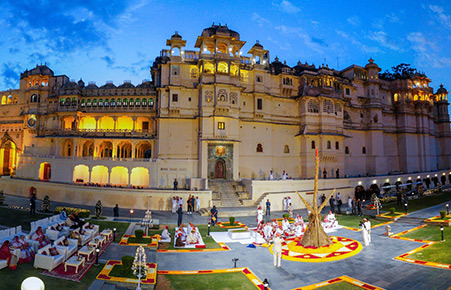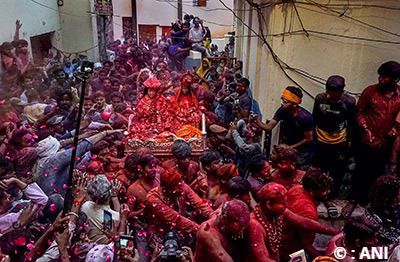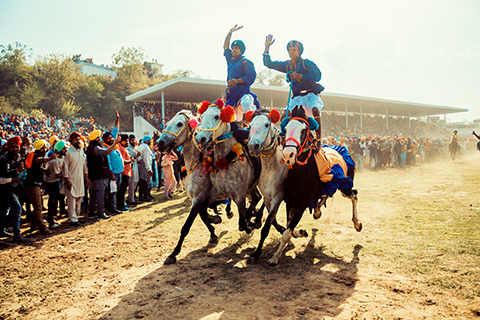LATHMAR HOLI
Another interesting form of Holi that takes place in India is played in Barsana, a small place near Mathura. Here, the festivities begin a few days in advance before the rest of India.
 This is a very different kind of Holi, where men and women get involved in a kind of mock battle along with smearing colors on each other. Women hurl sticks on men and they need to shield for defence. For this reason, it is famous as Lathmar Holi (Lath - Stick and Mar - An attack).
This is a very different kind of Holi, where men and women get involved in a kind of mock battle along with smearing colors on each other. Women hurl sticks on men and they need to shield for defence. For this reason, it is famous as Lathmar Holi (Lath - Stick and Mar - An attack).
As per the legend associated with the festival, Hindu god Krishna (from Nandgaon village) once visited his beloved Radha (in Barsana village) and teased her along with her friends. Taking that as an offense, they shoved him from the village. To recreate the scene, local men of Nandgaon invade Barsana village and drench local women with colors. In response to this, women chase them with sticks. They hurl the sticks and men shield themselves, as they are not supposed to retaliate. Adding interest to this, any of the men who are caught by the women in this mock battle need to dance in ladies’ attire. The whole scene is a treat for the eyes with people drenched in different colors and gathered in thousands, singing holi songs and sermons loudly.
HOLI WITH ROYALTY
In Deogarh or in other villages of Rajasthan where descendents of the Royal family still occupies a central place in the society, local people from the village pay a visit to them for Holi greetings and wishes before starting their celebrations.
Another venue that demands attention from culture lovers is the Holi celebrated in a royal style at the City Palace of Udaipur.
 Patronized by royalty, the celebration takes place over two days – the first day is reserved for ‘Holika Dahan’, a ceremony around a large bonfire is held on this day. The second day marks complete suffusion in colors.
Patronized by royalty, the celebration takes place over two days – the first day is reserved for ‘Holika Dahan’, a ceremony around a large bonfire is held on this day. The second day marks complete suffusion in colors.
Another additional element to the festivities in Udaipur is the ‘Nobti ki Swari’, a special procession with the King and his ministers. This is a unique ceremony that is exclusive to the Holi celebrations in Udaipur. Watch Holika Dahan ceremony as conducted by the Royal family of Udaipur.
SPIRITUAL HOLI
Varanasi, the city immersed in spirituality also celebrates this festival the same way as in other places of India. But here few more days are reserved to celebrate this festival in its own way. They call it Masaan’s Holi (which means Holi at the cremation ground). Sounds strange, isn’t it? Yes, Varanasi celebrates Holi in different ways on three different days i.e. Holi of Colors, Ranghari Ekadashi, and Masan Holi. The first one, Holi of colors, is celebrated on the same day and in the same way as the entire country.
 The celebration of the others i.e. Ranghari Ekadashi, and Masan Holi starts around 05 days earlier. While the celebration of Holi of colors is associated with god Krishna and goddess Radha, the other two are associated with god Shiva and goddess Parvati.
The celebration of the others i.e. Ranghari Ekadashi, and Masan Holi starts around 05 days earlier. While the celebration of Holi of colors is associated with god Krishna and goddess Radha, the other two are associated with god Shiva and goddess Parvati.
On Rangbhari Ekadashi, it is believed that god Shiva and goddess Parvati descend to Varanasi (Kashi). A huge procession is carried out by the devotees to celebrate the arrival of god Shiva with his soul mate in his own city. As ghosts and spirits are also believed to be the staunch followers of god Shiva and since they cannot be a part of the celebration of their reunion, god Shiva is believed to visit them the next day at the cremation ground (also called as Masan). So, on this day devotees join at Manikarnika Ghat and play with the ashes of burning pyres (instead of colors) and celebrate this grand festival, which starts with grand aarti (waving of lighted wicks before the deities in a spirit of humility and gratitude) at Masaan temple. The energy level of the devotees immersed in spirituality is difficult to describe in words.
HOLA MOHALLA
Around the historic township of Anandpur Sahib in Punjab, Hola Mohalla the masculine form of the feminine sounding Holi is celebrated for 03 days after the Holi festival, with a great pomp and show.
 The tradition to celebrate this festival was established by the tenth Sikh guru, Guru Govind Singh Ji, who wanted to add the martial element to the festivities. As the name translates to ‘Mock fight’, it marks the most impressive showcase of Sikh fearlessness.
The tradition to celebrate this festival was established by the tenth Sikh guru, Guru Govind Singh Ji, who wanted to add the martial element to the festivities. As the name translates to ‘Mock fight’, it marks the most impressive showcase of Sikh fearlessness.
Instead of playing with colours, be prepared to see power fuelled mock battles featuring sticks, knives, axes and swords. In addition to the mock battles, exhibitions, prayers, music, community kitchen etc. keeps one hooked here.
On 18th March 2022, jollification and fun times await us, as we will be celebrating ‘Holi - The Festival of colors’. We would like to take this opportunity to wish you a very colorful Holi, full of love, laughter, and joy". Our heart also goes out to the people suffering due to the war in Ukraine. We hope that peace prevails soon.


 Known as ‘Bhagoriya Holi’, the tribals of Jhabua participate in a `Swayamvara' or a mass marriage ceremony, in which the youngsters choose their life partners. This is an age-old tradition in which merriment knows no bounds which include singing, dancing, eating, drinking, and attending a wedding.
Known as ‘Bhagoriya Holi’, the tribals of Jhabua participate in a `Swayamvara' or a mass marriage ceremony, in which the youngsters choose their life partners. This is an age-old tradition in which merriment knows no bounds which include singing, dancing, eating, drinking, and attending a wedding.
 This is a very different kind of Holi, where men and women get involved in a kind of mock battle along with smearing colors on each other. Women hurl sticks on men and they need to shield for defence. For this reason, it is famous as Lathmar Holi (Lath - Stick and Mar - An attack).
This is a very different kind of Holi, where men and women get involved in a kind of mock battle along with smearing colors on each other. Women hurl sticks on men and they need to shield for defence. For this reason, it is famous as Lathmar Holi (Lath - Stick and Mar - An attack).
 Patronized by royalty, the celebration takes place over two days – the first day is reserved for ‘Holika Dahan’, a ceremony around a large bonfire is held on this day. The second day marks complete suffusion in colors.
Patronized by royalty, the celebration takes place over two days – the first day is reserved for ‘Holika Dahan’, a ceremony around a large bonfire is held on this day. The second day marks complete suffusion in colors.
 The celebration of the others i.e. Ranghari Ekadashi, and Masan Holi starts around 05 days earlier. While the celebration of Holi of colors is associated with god Krishna and goddess Radha, the other two are associated with god Shiva and goddess Parvati.
The celebration of the others i.e. Ranghari Ekadashi, and Masan Holi starts around 05 days earlier. While the celebration of Holi of colors is associated with god Krishna and goddess Radha, the other two are associated with god Shiva and goddess Parvati.
 The tradition to celebrate this festival was established by the tenth Sikh guru, Guru Govind Singh Ji, who wanted to add the martial element to the festivities. As the name translates to ‘Mock fight’, it marks the most impressive showcase of Sikh fearlessness.
The tradition to celebrate this festival was established by the tenth Sikh guru, Guru Govind Singh Ji, who wanted to add the martial element to the festivities. As the name translates to ‘Mock fight’, it marks the most impressive showcase of Sikh fearlessness.
 We can conduct a virtual destination awareness training program for your team or yourself or a virtual tour for your clients. Let us know the destination of your interest along with your convenient date / time and we will be happy to set up a program for you.
We can conduct a virtual destination awareness training program for your team or yourself or a virtual tour for your clients. Let us know the destination of your interest along with your convenient date / time and we will be happy to set up a program for you.



